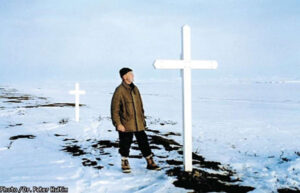Can these bones live?
For as long as I have been a pastor, I have preached in stories. The challenge in these last weeks, though, has been that I have no stories, no actual experience of a time such as this. I expect you don’t either. As a result, I have found myself leaning heavily into the sacred stories passed down to us. The raising of Lazarus which is told this Sunday is perfect for a time like this. So is Ezekiel’s vision in the 37th chapter.
We know this one well, of course. It has long captured our imagination in such a way that we may find ourselves singing about ‘dry bones’ even before we remember how Ezekiel’s vision must have lifted a people in exile so long ago. We know this one well. And yet, even so, it is hard to find a more contemporary ‘story’ which brings it alive.
So it was in these last days I decided to dig deep into what we know of the flu which swept the world in 1918, leaving millions upon millions dead in its wake. At first all I could uncover was statistics. And then I came upon the stories of those who remembered those devastating losses. And then I found this: the story of ‘dry bones living’ in the pursuit of one particular scientist over the last century.
Johan Hultin was a Swedish microbiologist studying at the University of Iowa. In 1951 he was looking for a topic for his dissertation work and was inspired by the suggestion that someone ought to go dig in the permafrost of the northern reaches of this continent. Certainly there would be still frozen in time there tissue samples of those who had died in that pandemic.
And so he did. He traveled to Brevig Mission, Alaska where some accounts have it that 72 of the 80 residents of that village died over the course of 5 days in November of 1918. He met with the village elders who gave him permission to excavate the mass grave. He was successful in finding well preserved tissue samples which he returned with to his lab in Iowa City where he began to try to grow the virus. It didn’t work. To be sure, it was 1951. His imagination was running far ahead of what science could do at the time.
Indeed, can these bones live?
Forty-six years later in 1997, Dr. Hultin read an article by Dr. Jeffrey Taubenberger of the Armed Forces Institute of Pathology in Washington, D.C., describing his own pursuit of what had led Dr. Hultin to Brevig Mission so long before. Only the tissue samples which had been preserved on slides with which Dr. Taubenberger and his team were working were limited and small. Dr. Hultin wrote him a letter telling him he knew where he could get him what he needed. And at the age of 72, back to Brevig Mission he went. (He is pictured here in that grave which held so many who had died.) This time he came away with two perfectly preserved lungs of a woman who would have been in her mid-20’s when she died. And within ten days, scientists were able to reconstruct the entire genome of the virus —- enhancing treatment for flu ever since. (As you know, I am no scientist and have only a rudimentary understanding of these things. The best account of this bit of medical/scientific history which I found was on the CDC website at this link.)
of Pathology in Washington, D.C., describing his own pursuit of what had led Dr. Hultin to Brevig Mission so long before. Only the tissue samples which had been preserved on slides with which Dr. Taubenberger and his team were working were limited and small. Dr. Hultin wrote him a letter telling him he knew where he could get him what he needed. And at the age of 72, back to Brevig Mission he went. (He is pictured here in that grave which held so many who had died.) This time he came away with two perfectly preserved lungs of a woman who would have been in her mid-20’s when she died. And within ten days, scientists were able to reconstruct the entire genome of the virus —- enhancing treatment for flu ever since. (As you know, I am no scientist and have only a rudimentary understanding of these things. The best account of this bit of medical/scientific history which I found was on the CDC website at this link.)
And oh, can’t these ‘bones’ live?
I love this story for the way in which it speaks into our current situation. God keeps on using gifted people to make bones ‘live.’ Even now.
I love this story for the way in which it plays out over time, especially for the way in which one scientist’s imagination was sparked half a century before, and even thought his project ‘failed’ then, the hope for discovery of that which could bring healing and life to the world never really left him.
 I love this story for this. In 1951, Johan Hultin traveled to Brevig, Alaska. He took pictures. When he returned to that mass grave 46 years later, it was the same, only the white crosses which had marked that grave had long since disintegrated. Before he left, he built new crosses for the people there as a token of his own gratitude for the gift they had given the world in allowing him to dig up that sacred place again.
I love this story for this. In 1951, Johan Hultin traveled to Brevig, Alaska. He took pictures. When he returned to that mass grave 46 years later, it was the same, only the white crosses which had marked that grave had long since disintegrated. Before he left, he built new crosses for the people there as a token of his own gratitude for the gift they had given the world in allowing him to dig up that sacred place again.
And I love this story for this. I am reminded through it that in the end, God always brings life out death. Always.
In times like this, we are well served by returning to the ancient stories which have always uplifted God’s people. I am also grateful to be able to find more recent examples of what God has always done ‘in making dry bones live.’ Indeed, I am surely grateful today for the gifts and the tenacity of one scientist, Dr. Johan Hultin and for the people of Brevig Mission, Alaska, who made this story possible.
- I am late in getting this post up this week. Given the strange demands of this time, I simply may not be able to keep the same schedule I have previously, although I will try to get something to you every week. I do hope that this comes to you in time, if not for your preaching, then perhaps just as a gift to you on the way. What stories have you experienced or uncovered which also speak into this time? If not Ezekiel, then where are you finding hope and promise in Scripture in these days?
- The story I offer above played out over fifty years. Can you think of other examples like this one where imagination was sparked long before the hoped for end came to be? How was hope kept alive in those times?
- Where do you see God ‘making dry bones live’ even now? Where is God bringing life out of death in your world today?
Do know that I hold all of you in my prayers during this time. Please let me know how you are doing.

I do appreciate this story – this history – and thank you for “unearthing” it as a resonant word for this time! Thanks for your faithful resurrecting of the Gospel message!!
Thanks, BJ. I really love this story and am glad you found it faithful. Blessings to you.
Thank you, Janet. You are in my prayers. Peace to you in these challenging times.
Thanks, Jerry. And to you, too.
Janet, Once again you have hit a home run for me. This is the inspiration I needed for my message that I will be live-streaming tomorrow morning .
We here in Virginia I suspect like most of the US are not meeting for face-to-face worship at least through April 25th. I am using Facebook a lot since that is what most of my congregation has access to — would love to hear other ideas for reaching a very low-tech congregation 🙂
I’m glad you found this story, helpful, Sue. I think whatever you are doing to reach your people is great. This is a hard time and we are all having to adjust and learn quickly! God Bless You in the days and weeks to come.
Thanks for this great story. It tied in Ezekiel perfectly
You’re welcome, Sharon. It is quite a story, isn’t it?
I really appreciated this story, Janet, and found it helpful as I preached this morning. Thank you for the extra research and the work you did to bring to life a story for the rest of us. Continued blessings of peace, strength and hope to you.
Thanks, Beth. It’s good to hear from you. Continued blessings to you as well for all you need!